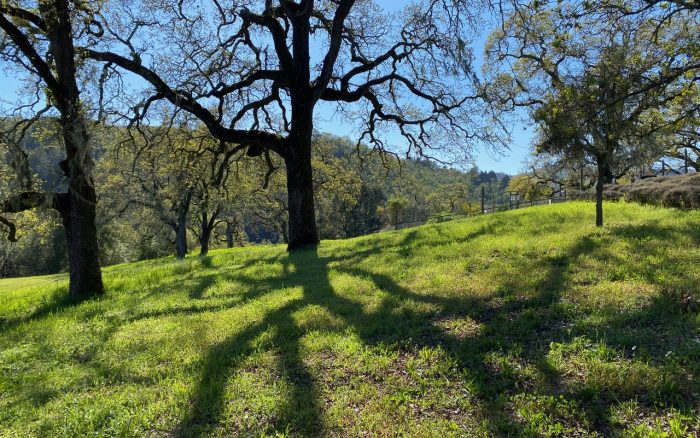I have worked before with Dyane Sherwood, the publisher of Fruits of Eden: Napa Valley 1991-2021 (which is currently being typeset. Dancing Raven Press, an imprint of Analytical Psychology Press). I know her propensity to mix visual imagery with the written word, a process quite different from the written word alone. “Take pictures of the oaks in all seasons,” she suggested and continued with talk of tiffs and pixels, a language I will never learn.
But she got me started on the long process of sorting through photographs of the last thirty years here on the ranch. Yes, I have photos of the oaks in every season: the first unfolding of tiny reddish leaves and dangling blooms which, fertilized, will become black oak acorns, the fullness of summer valley oak boughs, and the sculpted bareness of their wintering form. I have photos taken on my daily walks with the goats along deer paths to the ridge and down through the gully of the ephemeral creek, of the Buddha meditating by the full stock pond, and then, six months later, of my hiking booted feet standing on the dry, cracked bottom of the same.
The more I sorted the photos onto the piles of related chapters, the more I was drawn into the joy of land that I figured would take a lifetime to know. The arc of sunrises and sunsets across the east and the west, sundials of seasons. The march of wildflowers beginning with winter rains and extending into June. The gouged antler shed in a fight in the most remote area of the ranch—a bobcat hunting gophers by the garden.
Photos introduce that right brain connection, an openness to what is present, collected like shells on a shoreline of life, like bones and feathers from the trail. Then there is the culling–they can’t all be there, like life: what we will and will not do, what we will attend to, and what we won’t.
I chose others’ photos, too, photos by professional photographer friends who traveled this activist path with me out of love for what needs to be protected. Bill Hocker’s reflections on light and ash after the 2017 and 2020 fires almost burned his home. Lowell Downey’s photo of the valley oak west of our home as it arched over the rows of helichrysum, the golden leaves transparent in the late afternoon sun. Deborah O’Grady’s photo of a stately valley oak standing alongside a dirt road. One year an intern, Cristin McDonald, photographed our old dogs Leo and Moka on a goatwalk, and there’s my sister Judy’s photo of the 500-year-old white oak in the cemetery where my great grandparents are buried. The book is a kaleidoscope of memories frozen in image, catalysts of reflection.
I have written books before. Each is like a child—unique in itself. That is true of Fruits of Eden as well. The writing was in part an act of desperation. When land and the environment are commodified, so much is at stake. But this work on the design reminds me of what really motivated my land-use activism. We protect what we love.
